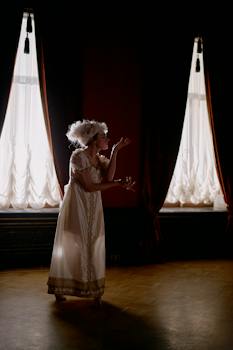

-
Table of Contents
"Unearth the Enigmatic: 7 Strange Historical Facts"
Introduction
Introduction:
Throughout history, there have been numerous strange and intriguing events that have left historians and researchers puzzled. From bizarre rituals to unexplained phenomena, these historical facts offer a glimpse into the peculiarities of the past. In this article, we will explore seven strange historical facts that continue to captivate our curiosity and challenge our understanding of the world.
Unusual Medical Practices Throughout History
Unusual Medical Practices Throughout History
Throughout history, medical practices have evolved significantly. While modern medicine has made remarkable advancements, it is fascinating to look back at some of the strange and unusual medical practices that were once considered standard. These practices, although bizarre by today's standards, provide insight into the beliefs and knowledge of the time. Let's explore seven strange historical medical practices that will leave you grateful for modern medicine.
Firstly, bloodletting was a common practice in ancient times. It was believed that by removing blood from the body, balance could be restored and illnesses could be cured. This practice involved using leeches or sharp instruments to make incisions and drain blood. While it may seem barbaric now, bloodletting was widely accepted and practiced for centuries.
Another strange medical practice was trepanation, which involved drilling a hole into the skull. This procedure was performed to relieve pressure on the brain or to release evil spirits believed to be causing mental illness. The trepanation holes were often left open, allowing the brain to be exposed. Surprisingly, some patients survived this procedure, indicating that the human body has a remarkable ability to heal.
Moving on, the use of mercury as a medical treatment is both strange and dangerous. Mercury was believed to have healing properties and was used to treat various ailments, including syphilis. However, mercury is highly toxic and can cause severe damage to the nervous system. It is astonishing to think that such a harmful substance was once considered a legitimate medical treatment.
In the realm of dentistry, the use of urine as a mouthwash was a common practice in ancient Rome. Urine was believed to have antiseptic properties and was used to clean and whiten teeth. This practice may seem repulsive to us today, but it highlights the limited knowledge and resources available at the time.
Additionally, the use of tobacco smoke enemas was a peculiar medical practice in the 18th century. It was believed that blowing tobacco smoke into the rectum could revive drowning victims. This practice was also used to treat various ailments, including headaches and constipation. While it may sound absurd, tobacco smoke enemas were widely accepted and practiced by medical professionals of the time.
Furthermore, the use of live animals in medical treatments was not uncommon in history. For instance, in ancient Egypt, live worms were used to treat infected wounds. The worms were believed to eat away the dead flesh, promoting healing. Similarly, in medieval Europe, live leeches were used to suck out "bad blood" from patients. These practices may seem bizarre, but they reflect the limited understanding of infection and wound healing at the time.
Lastly, the use of electric shock therapy in the 19th and early 20th centuries was a strange medical practice. Electric shocks were administered to patients suffering from various mental illnesses, with the aim of jolting them back to sanity. While this practice may have had some short-term effects, it was ultimately ineffective and often caused more harm than good.
In conclusion, the history of medical practices is filled with strange and unusual methods that were once considered standard. From bloodletting to trepanation, the use of mercury to tobacco smoke enemas, these practices highlight the limited knowledge and understanding of the human body throughout history. While we may find these practices bizarre and even dangerous today, they serve as a reminder of the remarkable progress made in modern medicine. We can be grateful for the advancements that have led to safer and more effective treatments, ensuring our well-being and longevity.
Bizarre Superstitions and Beliefs of Ancient Civilizations

Bizarre Superstitions and Beliefs of Ancient Civilizations
Throughout history, civilizations have developed their own unique beliefs and superstitions. Some of these beliefs may seem strange or even absurd to us today, but they played a significant role in shaping the cultures of ancient civilizations. In this article, we will explore seven strange historical facts about the bizarre superstitions and beliefs of ancient civilizations.
1. Ancient Egyptians believed in the power of amulets and charms. They believed that these objects had the ability to protect them from evil spirits and bring good luck. Egyptians would often wear amulets in the shape of animals or gods, such as the scarab beetle or the Eye of Horus, to ward off evil and ensure their well-being.
2. In ancient Greece, people believed in the power of curses. It was believed that a curse could bring misfortune or even death to its target. To protect themselves from curses, Greeks would often wear amulets or perform rituals to ward off evil spirits. They also believed in the power of the evil eye, a curse that could be cast by a jealous or envious person.
3. The ancient Romans had a peculiar belief in the power of the phallus. They believed that the phallus symbolized fertility and good luck. Romans would often wear phallic amulets or display phallic symbols in their homes to bring prosperity and ward off evil spirits. This belief in the power of the phallus was also reflected in their art and architecture.
4. In ancient China, people believed in the power of feng shui, the art of arranging objects and spaces to harmonize with the natural flow of energy. It was believed that by arranging their homes and workplaces according to feng shui principles, people could attract good luck and prosperity into their lives. This belief is still widely practiced in China and other parts of the world today.
5. The ancient Mayans had a unique belief in the power of bloodletting. They believed that by sacrificing blood, either through self-inflicted wounds or animal sacrifices, they could appease the gods and ensure the well-being of their community. Bloodletting rituals were an integral part of Mayan religious ceremonies and were often performed by priests or rulers.
6. In ancient India, people believed in the power of astrology. They believed that the positions of the stars and planets at the time of a person's birth could influence their personality, relationships, and future. Astrology played a significant role in Indian society, with astrologers consulted for important decisions such as marriage, business ventures, and even political matters.
7. The ancient Norse people believed in the power of runes, ancient symbols with magical properties. Runes were used for divination, protection, and communication with the gods. Norse warriors would often inscribe runes on their weapons and armor to bring them luck and protection in battle. Today, runes are still used in modern pagan and neo-pagan practices.
These strange historical facts about the bizarre superstitions and beliefs of ancient civilizations offer a glimpse into the rich and diverse cultures of the past. While some of these beliefs may seem peculiar to us today, they were an integral part of the daily lives and rituals of ancient peoples. Exploring these beliefs allows us to better understand the complexities of human history and the fascinating ways in which our ancestors sought to make sense of the world around them.
Mysterious Disappearances and Unsolved Mysteries in History
Mysterious Disappearances and Unsolved Mysteries in History
Throughout history, there have been numerous strange and unexplained disappearances that continue to baffle experts and captivate the imagination of people around the world. These unsolved mysteries have left behind a trail of questions and speculation, with no concrete answers in sight. In this article, we will explore seven of the most perplexing historical disappearances that have puzzled investigators for decades.
One of the most famous unsolved mysteries is the disappearance of Amelia Earhart, the renowned aviator who vanished while attempting to circumnavigate the globe in 1937. Despite extensive search efforts, no trace of Earhart or her plane has ever been found. Theories range from crash landings on remote islands to capture by the Japanese government, but the truth remains elusive.
Another baffling case is that of the Roanoke Colony, a group of English settlers who mysteriously vanished from their North Carolina settlement in the late 16th century. The only clue left behind was the word "Croatoan" carved into a tree, leaving historians to speculate about the fate of the colonists. Did they assimilate with local Native American tribes, or did something more sinister befall them?
Moving on to the 20th century, the disappearance of Judge Joseph Force Crater in 1930 shocked the nation. Crater, a prominent New York judge, vanished without a trace after leaving a restaurant. Despite extensive investigations, no evidence of his whereabouts or what happened to him has ever been discovered. The case remains open, and the public continues to speculate about his fate.
In 1971, a man known as D.B. Cooper pulled off one of the most audacious heists in history. Cooper hijacked a plane, demanded a ransom of $200,000, and then parachuted out of the aircraft, disappearing into thin air. Despite an extensive manhunt and ongoing investigations, Cooper's true identity and fate remain unknown, making him one of the most enigmatic figures in criminal history.
The mysterious disappearance of the USS Cyclops in 1918 is another perplexing case. This massive Navy ship vanished without a trace in the Bermuda Triangle, an area notorious for unexplained disappearances. Despite numerous theories, including storms, structural failure, or even a possible encounter with a supernatural force, the fate of the Cyclops and its 309 crew members remains a haunting mystery.
In 1947, the disappearance of Flight 19, a group of five U.S. Navy torpedo bombers, added to the legend of the Bermuda Triangle. The planes vanished during a routine training mission, and despite extensive search efforts, no wreckage or survivors were ever found. The incident sparked widespread speculation about the supernatural forces at play in the Bermuda Triangle.
Lastly, the vanishing of the crew of the Mary Celeste in 1872 has puzzled historians for over a century. The ship was found adrift in the Atlantic Ocean with no crew on board, yet everything appeared to be in order. There were no signs of struggle or foul play, leaving experts to wonder what could have driven the crew to abandon their vessel.
These seven strange historical disappearances and unsolved mysteries continue to captivate the public's imagination. From famous aviators to naval vessels and ordinary people, the unanswered questions surrounding these cases remind us that even in our modern world, there are still mysteries that defy explanation. As time goes on, perhaps new evidence or breakthroughs in technology will shed light on these enigmatic events, but until then, they remain intriguing puzzles waiting to be solved.
Q&A
1. What is the significance of the Dancing Plague of 1518?
The Dancing Plague of 1518 was a phenomenon in which hundreds of people in Strasbourg, France, danced uncontrollably for days or even weeks, resulting in exhaustion, injury, and even death.
2. Who was the first person to survive going over Niagara Falls in a barrel?
Annie Edson Taylor became the first person to survive going over Niagara Falls in a barrel on October 24, 1901.
3. What is the story behind the Great Emu War in Australia?
The Great Emu War was a failed military operation conducted by the Australian government in 1932 to control the emu population in Western Australia. Despite the use of machine guns, the emus proved difficult to eradicate, resulting in a humorous and unusual conflict.
Conclusion
In conclusion, history is filled with strange and fascinating facts that often defy our expectations. From the bizarre practices of ancient civilizations to the peculiar habits of historical figures, these seven strange historical facts offer a glimpse into the peculiarities of the past.












